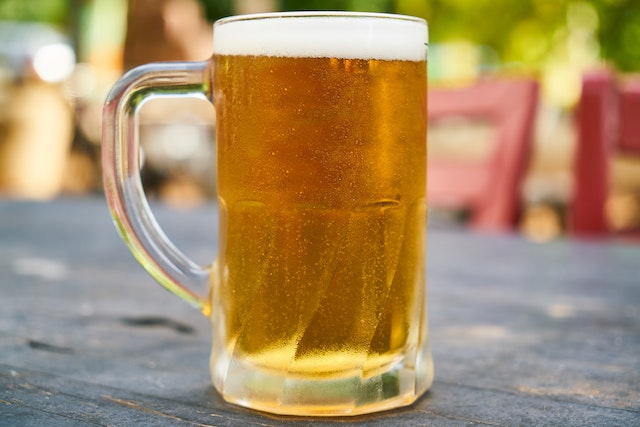
Why does beer have alcohol? Because the yeast cells in the beer feed on sugar and produce ethanol.
Yeast is an egg-shaped single-celled fungus. There are 1,500 different species of yeast. 1% of all fungal species are yeast. Humans use yeast for several things, but the most common are bread and alcoholic drinks. When yeast cells are given sugar, they metabolize it for energy so that they can reproduce. As a byproduct of this metabolism, they release ethanol and carbon dioxide.
To make beer, the yeast needs a source of sugar. The first step is to prepare that sugar. Different beers have different ingredients, but all beers use grain as their source of sugar. The most common grain is barley. The barley has to be malted before it can be used. That means the barley grains are soaked in water and allowed to germinate. They are soaked for about 40 hours and then germinated for 5 days. When they have just started to germinate, they are dried in a kiln. This process of malting releases enzymes in the grain that convert the starches in the grains into a type of sugar that the yeast can use. The dried grains are crushed to break them open and then mixed with hot water. The enzymes in the malt break the long chain carbohydrates down into shorter sugar chains.
Hops are then added. They are bitter and they balance out the sweet flavor from the malted barley. The hops also have antibiotic properties and can keep bacteria away from the beer. The hops are filtered out and the beer mash is rapidly cooled down before the yeast is added. The yeast starts to metabolize the sugars in the malted barley and it releases carbon dioxide and ethanol. The carbon dioxide is released into the atmosphere, but the alcohol stays.
There are two different categories of yeast used when making beer. The first category are yeasts that float on the top of the liquid. They are called “top-cropping” yeasts. They are fermented at slightly higher temperatures and they ferment quite quickly. Because the yeast floats in the liquid, the resultant beers are dark and cloudy and this type of yeast is used to make ales, stouts, and porters. The second type of yeast is “bottom-cropping” yeasts. These yeast sink to the bottom of the liquid and they are fermented at a lower temperature, meaning they take longer to ferment. When they have finished, the waste yeast sinks to the bottom of the liquid, making a much clearer beer. Lagers and pilsners are made with this kind of yeast.
Yeast makes the alcohol in wine in the same way. Yeast produces alcohol, but the alcohol is also toxic to the yeast. It can only survive until the alcohol level reaches about 16% and then the yeast dies. That is why most wines only have an alcohol strength of about 16%.
Scientists have long wondered why yeast produces alcohol. It kills them and it is a waste of their energy. To produce the alcohol, they have to use part of the energy they get from the sugar they have metabolized. There must be a reason for this because evolution would have removed it if there were no reason, but scientists have had a lot of trouble working out what that reason might be. One theory is that it is a safety mechanism to protect the yeast cell. When they metabolize the sugar, they move around a lot and they could do damage to their cells. The theory is that they release some of the energy they are taking in as alcohol to lower the risk of cell damage. This is backed up by the fact that yeast don’t produce alcohol straight away. They wait until their energy level has risen to a certain point.
After the beer has been made, most of the yeast is either dead or dormant. There may still be some live yeast in the liquid. These are all filtered out before the beer is canned. The live yeast can be used again to make more beer. In beer brewed at home, live yeast can sometimes be left in the beer. This can cause problems if drunk because the yeast can start metabolizing the sugars in your stomach and releasing carbon dioxide and alcohol, causing stomachaches.
Yeast is also used to make bread. The yeast is mixed in to feed on the sugars in the wheat flour. As they metabolize the sugars they release alcohol and carbon dioxide. The bread dough is sealed and elastic. The carbon dioxide has nowhere to escape to, so it makes the dough inflate. The yeast produces alcohol as well, but it evaporates out when the bread is baked. And this is what I learned today.
Sources
https://www.sciencedaily.com/releases/2019/01/190107112950.htm
https://en.wikipedia.org/wiki/Brewing
https://www.biocompare.com/Life-Science-News/357370-Why-Does-Yeast-Produce-Ethanol/
https://www.nature.com/scitable/topicpage/yeast-fermentation-and-the-making-of-beer-14372813/
http://www.botany.hawaii.edu/faculty/wong/BOT135/Lect14.htm
https://www.thespruceeats.com/basic-yeast-information-304312
